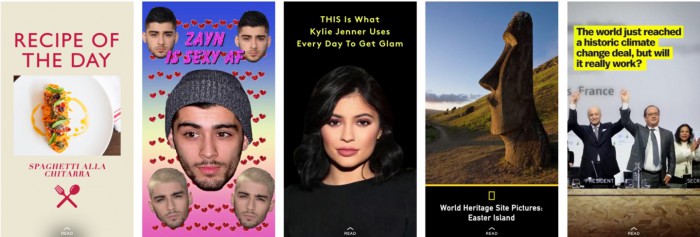In 2015, we saw the rise of publishers’ content being consumed on platforms such as Facebook, Snapchat, Periscope, Apple News, Apple TV…and the list goes on. We also saw many publishers reach a confident stride on these platforms, building teams charged with churning out original content in new, native formats, such as vertical video for Snapchat Discover or tiltable images for Facebook Instant Articles.
 In 2016, this trend of content creation for distributed platforms will continue, even on platforms that haven’t even launched yet (including ugh, yeah, virtual reality platforms
In 2016, this trend of content creation for distributed platforms will continue, even on platforms that haven’t even launched yet (including ugh, yeah, virtual reality platforms 
But while publishers will continue to gain confidence in content-generation in this new distributed platform world, in 2016 they’ll have to face the big gaping hole of revenue generation on these platforms — which until now has been an afterthought.
While advertising on-platform remains a steady chunk of publishers’ revenue, the increase of readers consuming content not on publishers’ websites will necessitate some serious brainstorming on how to make money on those other platforms. When advertising revenue is based on pageviews, clicks, and engagement metrics, as it currently is, how will advertising formats and metrics evolve on these platforms?
These are real challenges we’ll have to face, but there does exist a silver lining: These platforms are wonderful opportunities to invent exciting, new advertising formats and revenue streams in partnership with platforms, as well as extend and grow our brands and audiences.
Advertising and revenue has largely been an afterthought on these platforms. Platforms like Facebook Instant Articles and Google AMP are focused on delivering better page performance, molding content into their respective native formats, and of course, generating more revenue for themselves by getting eyeballs onto their platform and keeping them there.
With this in mind, pushing the platforms to innovate their revenue products is important. Some platforms like Facebook Instant Articles are indeed bowing to publishers’ feedback and slowly making their formats more flexible. But is this enough, and should we really rely on these platforms, which have differing incentives, to push boundaries in advertising?
I predict that many publishers will begin to recognize the need to innovate and push new advertising formats from within, rather than relying on other platforms to do it for them. They will begin to push advertising both on their websites as well as other platforms. If the adblocking hullabaloo earlier this year signaled anything, it was that the ad tech industry is slow to change and has some serious problems on the brink of a tidal wave of change. Readers are tired of poorly performing ads, and publishers are too. Do you have an internal revenue products team thinking about these problems? Are they working closely with your editorial, product, and sales teams? I think in 2016 we will begin to see publishers playing catchup in the ad-tech space by taking matters into their own hands. (Disclaimer: I work on the revenue team at Vox Media.)
There’s another side of this coin, though. It’s not all doom and gloom — although platforms tend to treat advertising as an afterthought, they do offer an incredibly exciting opportunity to build your brand and grow your audience. But that means your brand must remain relevant and identifiable across all platforms and formats. If you build a strong brand, readers and users on other platforms will want to engage with you and your content, no matter what the context, platform, or format.
What does having a strong and relevant brand even mean? In my mind, a “strong brand” is one that is immediately recognizable and identifiable. This comes through in design elements such as colors, typography, motion, and more. This can also come through in the nature of your content — are you known for explainers? Investigative content? Stunning photography? One trend I’ve noticed, particularly on Snapchat, is that many publishers are afraid to embrace their brand and are instead, allowing the platform to dictate it. Just because everyone else is posting gifs of cats shooting lasers out of their eyes, doesn’t mean it’s right for your brand.
“Brand relevance” on the other hand, is a term coined by marketer David Aaker and is defined by a brand that has “carved out a new category for itself for which other competitors are irrelevant.” For instance, if you’re the only publisher focused on a niche audience, like millennial moms, you have strong brand relevance.

This is a winning combination; a distinguishable brand across multiple platforms that speaks directly to a desirable, niche audience will create meaningful exposure to new audiences as well as a pathway for more engaged and loyal readers. And this engagement and loyalty ultimately translates into dollars should you choose to explore other revenue streams such as, say, an events business, a television show, or yes, even a paywall for exclusive insider content.
Surviving and thriving in a distributed platform world in 2016 will be important, but simply view it as an opportunity to extend and grow your brand and your revenue. By viewing it this way, your website won’t necessarily die — it will simply have more platforms leading back to it with readers who really, truly want to be there. And that kind of loyalty is worth a whole lot of money.
Alisha Ramos is a senior designer on the revenue products team at Vox Media.